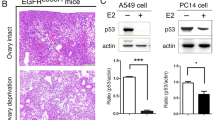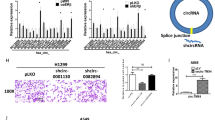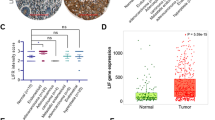Abstract
Estrogen is involved in promoting lung cancer cell division and metastasis. MICA and MICB function as ligands for NKG2D, an important immunoreceptor expressed on natural killer (NK) cells. However, whether estrogen regulates MICA/B expression and affects tumor immune escape remains unknown. In this study, we measured the mRNA levels of MICA, MICB and ADAM17in non-small cell lung cancer (NSCLC) cell lines treated with estrogen. Surface expression of MICA/B on LTEP-a2 and A549 was detected using flow cytometry. We demonstrate that both mRNA and secretory protein levels of MICA/B in lung adenocarcinoma cell lines were upregulated by estradiol. Estradiol enhanced the expression of ADAM17, which was associated with the secretion of MICA/B. This secretion of MICA/B downregulated the NKG2D receptor on the surface of NK92 cells and impaired the cytotoxic activity of NK cells. Estradiol enhanced the expression of ADAM17, which was associated with the secretion of MICA/B. Furthermore, a significant correlation between the concentration of estradiol and the expression of MICA was found in tumor tissues of NSCLC patients. Therefore, we conclude that estrogen can regulate the expression and secretion of MICA/B through ADAM17, which helps lung cancer cells escape NKG2D-mediated immune surveillance.
This is a preview of subscription content, access via your institution
Access options
Subscribe to this journal
Receive 12 digital issues and online access to articles
$119.00 per year
only $9.92 per issue
Buy this article
- Purchase on Springer Link
- Instant access to full article PDF
Prices may be subject to local taxes which are calculated during checkout






Similar content being viewed by others
References
Siegel R, Ward E, Brawley O, Jemal A . Cancer statistics, 2011: the impact of eliminating socioeconomic and racial disparities on premature cancer deaths. CA Cancer J Clin 2011; 61: 212–236.
Sasco AJ, Secretan MB, Straif K . Tobacco smoking and cancer: a brief review of recent epidemiological evidence. Lung Cancer 2004; 45( Suppl 2): 3–9.
Sun S, Schiller JH, Gazdar AF . Lung cancer in never smokers—a different disease. Nat Rev Cancer 2007; 7: 778–790.
Carey MA, Card JW, Voltz JW, Arbes SJ Jr, Germolec DR, Korach KS et al. It's all about sex: gender, lung development and lung disease. Trends Endocrinol Metab 2007; 18: 308–313.
Couse JF, Lindzey J, Grandien K, Gustafsson JA, Korach KS . Tissue distribution and quantitative analysis of estrogen receptor-alpha (ERalpha) and estrogen receptor-beta (ERbeta) messenger ribonucleic acid in the wild-type and ERalpha-knockout mouse. Endocrinology 1997; 138: 4613–4621.
Raso MG, Behrens C, Herynk MH, Liu S, Prudkin L, Ozburn NC et al. Immunohistochemical expression of estrogen and progesterone receptors identifies a subset of NSCLCs and correlates with EGFR mutation. Clin Cancer Res 2009; 15: 5359–5368.
Abe K, Miki Y, Ono K, Mori M, Kakinuma H, Kou Y et al. Highly concordant coexpression of aromatase and estrogen receptor beta in non-small cell lung cancer. Hum Pathol 2010; 41: 190–198.
Hershberger PA, Stabile LP, Kanterewicz B, Rothstein ME, Gubish CT, Land S et al. Estrogen receptor beta (ERbeta) subtype-specific ligands increase transcription, p44/p42 mitogen activated protein kinase (MAPK) activation and growth in human non-small cell lung cancer cells. J Steroid Biochem Mol Biol 2009; 116: 102–109.
Stabile LP, Lyker JS, Gubish CT, Zhang W, Grandis JR, Siegfried JM . Combined targeting of the estrogen receptor and the epidermal growth factor receptor in non-small cell lung cancer shows enhanced antiproliferative effects. Cancer Res 2005; 65: 1459–1470.
Mah V, Seligson DB, Li A, Márquez DC, Wistuba II, Elshimali Y et al. Aromatase expression predicts survival in women with early-stage non-small cell lung cancer. Cancer Res 2007; 67: 10484–10490.
Zhao G, Zhao S, Wang T, Zhang S, Lu K, Yu L et al. Estrogen receptor β signaling regulates the progression of Chinese non-small cell lung cancer. J Steroid Biochem Mol Biol 2011; 124: 47–57.
Raulet DH . Roles of the NKG2D immunoreceptor and its ligands. Nat Rev Immunol 2003; 3: 781–790.
Bauer S, Groh V, Wu J, Steinle A, Phillips JH, Lanier LL et al. Activation of NK cells and T cells by NKG2D, a receptor for stress-inducible MICA. Science 1999; 285: 727–729.
Wu JD, Higgins LM, Steinle A, Cosman D, Haugk K, Plymate SR . Prevalent expression of the immunostimulatory MHC class I chain-related molecule is counteracted by shedding in prostate cancer. J Clin Invest 2004; 114: 560–568.
Doubrovina ES, Doubrovin MM, Vider E, Sisson RB, O'Reilly RJ, Dupont B et al. Evasion from NK cell immunity by MHC class I chain-related molecules expressing colon adenocarcinoma. J Immunol 2003; 171: 6891–6899.
Groh V, Wu J, Yee C, Spies T . Tumour-derived soluble MIC ligands impair expression of NKG2D and T-cell activation. Nature 2002; 419: 734–738.
Jinushi M, Takehara T, Tatsumi T, Hiramatsu N, Sakamori R, Yamaguchi S et al. Impairment of natural killer cell and dendritic cell functions by the soluble form of MHC class I-related chain A in advanced human hepatocellular carcinomas. J Hepatol 2005; 43: 1013–1020.
Basu S, Pioli PA, Conejo-Garcia J, Wira CR, Sentman CL . Estradiol regulates MICA expression in human endometrial cells. Clin Immunol 2008; 129: 325–332.
Zhao G, Nie Y, Lv M, He L, Wang T, Hou Y . ERβ-mediated estradiol enhances epithelial mesenchymal transition of lung adenocarcinoma through increasing transcription of midkine. Mol Endocrinol 2012; 26: 1304–1315.
Chitadze G, Bhat J, Lettau M, Janssen O, Kabelitz D . Generation of soluble NKG2D ligands: proteolytic cleavage, exosome secretion and functional implications. Scand J Immunol 2013; 78: 120–129.
Salih HR, Rammensee HG, Steinle A . Cutting edge: down-regulation of MICA on human tumors by proteolytic shedding. J Immunol 2002; 169: 4098–4102.
Waldhauer I, Goehlsdorf D, Gieseke F, Weinschenk T, Wittenbrink M, Ludwig A et al. Tumor-associated MICA is shed by ADAM proteases. Cancer Res 2008; 68: 6368–6376.
Waldhauer I, Steinle A . Proteolytic release of soluble UL16-binding protein 2 from tumor cells. Cancer Res 2006; 66: 2520–2526.
Holdenrieder S, Stieber P, Peter WA, Nagel D, Steinle A, Salih HR . Soluble MICA in malignant diseases. Int J Cancer 2006; 118: 684–687.
Rebmann V, Schutt P, Brandhorst D, Opalka B, Moritz T, Nowrousian MR et al. Soluble MICA as an independent prognostic factor for the overall survival and progression-free survival of multiple myeloma patients. Clin Immunol 2007; 123: 114–120.
Groh V, Rhinehart R, Secrist H, Bauer S, Grabstein KH, Spies T . Broad tumour-associated expression and recognition by tumour-derived γδT cells of MICA and MICB. Proc Natl Acad Sci USA 1999; 96: 6879–6884.
Das H, Groh V, Kuijl C, Sugita M, Morita CT, Spies T et al. MICA engagement by human T cells enhances their antigen-dependent effector function. Immunity 2001; 15: 83–93.
Groh V, Rhinehart R, Randolph-Habecker J, Topp MS, Riddell SR, Spies T . Costimulation of CD8 αβT cells by NKG2D via engagement by MIC induced on virus infected cells. Nat Immunol 2001; 2: 255–260.
Tieng V, Le Bouguénec C, du Merle L, Bertheau P, Desreumaux P, Janin A et al. Binding of Escherichia coli adhesin AfaE to CD55 triggers cell-surface expression of the MHC class I-related molecule MICA. Proc Natl Acad Sci USA 2002; 99: 2977–2982.
Osborne CK, Bardou V, Hopp TA, Chamness GC, Hilsenbeck SG, Fuqua SA et al. Role of the estogen receptor coactivator AIB1 (SRC-3) and HER-2/neu in tamoxifen resistance in breast cancer. J Natl Cancer Inst 2003; 95: 353–361.
Okita R, Mougiakakos D, Ando T, Mao Y, Sarhan D, Wennerberg E et al. HER2/HER3 signaling regulates NK cell-mediated cytotoxicity via MHC class I chain-related molecule A and B expression in human breast cancer cell lines. J Immunol 2012; 188: 2136–2145.
Hao S, Li P, Zhao J, Hu Y, Hou Y . 17β-Estradiol suppresses cytotoxicity and proliferative capacity of murine splenic NK1.1+ cells. Cell Mol Immunol 2008; 5: 357–364.
Alter G1, Malenfant JM, Altfeld M . CD107a as a functional marker for the identification of natural killer cell activity. J Immunol Methods 2004; 294: 15–22.
Acknowledgements
This work was supported by the National Natural Science Foundation of China (81101552 and 81201598), and the Natural Science Foundation of Jiangsu Province (BK2011571).
Author information
Authors and Affiliations
Corresponding authors
Additional information
Supplementary Information accompanies the paper on Cellular & Molecular Immunology's website. (http://www.nature.com/cmi).
Supplementary information
Rights and permissions
About this article
Cite this article
Ren, J., Nie, Y., Lv, M. et al. Estrogen upregulates MICA/B expression in human non-small cell lung cancer through the regulation of ADAM17. Cell Mol Immunol 12, 768–776 (2015). https://doi.org/10.1038/cmi.2014.101
Received:
Revised:
Accepted:
Published:
Issue Date:
DOI: https://doi.org/10.1038/cmi.2014.101
Keywords
This article is cited by
-
miR-4299 inhibits tumor progression in pancreatic cancer through targeting ADAM17
Molecular and Cellular Biochemistry (2023)
-
Impact of COVID-19 on the Cardiovascular System: A Review of Available Reports
Cardiovascular Drugs and Therapy (2021)
-
The fatty-acid amide hydrolase inhibitor URB597 inhibits MICA/B shedding
Scientific Reports (2020)
-
COVID-19 in the heart and the lungs: could we “Notch” the inflammatory storm?
Basic Research in Cardiology (2020)
-
Inhibition of SARS-CoV-2 entry through the ACE2/TMPRSS2 pathway: a promising approach for uncovering early COVID-19 drug therapies
European Journal of Clinical Pharmacology (2020)



